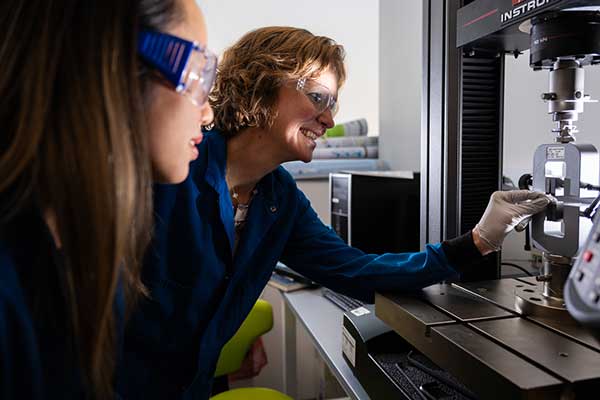Examining Mice to Study Bone Development

MIE/BioE Professor Sandra Shefelbine and Lindsey Young, PhD’28, bioengineering, are working on innovative research on bone development by examining two species of deer mice to determine how much of bone development is evolutionary or can be impacted by physical activity.
This article originally appeared on Northeastern Global News. It was published by Noah Lloyd. Main photo: “If you put more load on the bones, they get stronger,” says Shefelbine says. “But we don’t really know how bones do that.” A new experiment, conducted by her and Ph.D. student Lindsey Young (foreground) investigates those mechanisms. Photos by Alyssa Stone/Northeastern University.
These mice are trading places to teach us about bone development
Go to the gym, lift a few weights. We all know that this will help you build stronger muscles — but did you know that this can help your bones get stronger, too?
New research from Northeastern University will study just how much of bone development is evolutionary and how much can be impacted by targeted, specific physical activity.
“If you put more load on the bones, they get stronger,” says Sandra Shefelbine, associate dean of space and special initiatives and professor of both mechanical and industrial engineering and bioengineering. “But we don’t really know how bones do that.”
Much of her research, she says, “is trying to figure out how that works, and how we can tap into that for therapeutic benefit.”
Trading places
The experiment will look at two species of deer mouse: a wild burrowing variety from the American Southwest and non-burrowing laboratory mice. Because deer mice are found “in a variety of habitats, each of these species have adapted accordingly to whatever habitat they’re in,” says Lindsey Young, the Ph.D. student leading the project under Shefelbine’s guidance.
Because the lab mice don’t burrow to create their homes — they prefer to either nest or steal other animals’ burrows, Young notes — Young’s previous research identified that the southwestern burrowing mice’s bones responded to load differently than their laboratory cousins.
“We found that the wild mice had bones that adapted through their shape much greater than these laboratory mice,” Young continues. But “why is this the case? We see the bones change, but we don’t know the whole process that goes behind this.”
The mice also have behavioral differences. The wild mice, Young notes, like to perform backflips. “They run around like crazy. They’ve got so much energy.”
Young and Shefelbine aim to determine how much of the deer mice’s bone adaptation is driven by activity in their environment — burrowing or not burrowing — versus evolutionary — two neighboring species that evolved within the same genus.
To examine this, their mice will swap places: the wild southwestern mice will move into a more controlled laboratory environment and the lab mice will be moved into a special chamber that encourages burrowing. Within this environment, the researchers will observe the mice with specialized “X-ray technology, where we are able to track and visualize the movement of these mice as they create their burrows or run around,” Shefelbine says.
Read full story at Northeastern Global News